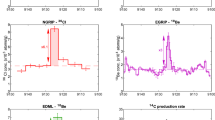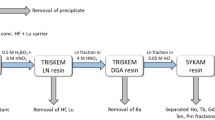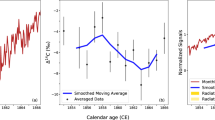Abstract
Cosmogenic 26Al (half life = 7.2 × 105 yr) and 10Be (1.5 × 106 yr) are produced continually in the atmosphere by cosmic rays. They are fixed on aerosol particles and, after a relatively short time (∼1 yr) precipitate to the Earth's surface, and from there into various geophysical reservoirs. The possibility of using this pair of isotopes as a dating tool, independent of cosmic ray intensity variations, was discussed some time ago1. However, except for several rare exceptions2,3 the very low activities of these isotopes, especially 26Al, have dissuaded workers from such studies by classical radioactive counting techniques. The development of accelerator mass spectrometry offers to change this situation dramatically. Cosmogenically produced 10Be has already been measured by several groups using accelerator mass spectrometry4. While the technique has also been used to detect artificially produced5–7 and extraterrestrial8, 26Al the 26Al/27Al ratio in each case was several orders of magnitude greater than that expected in natural terrestrial samples. We report here the first accelerator mass spectrometry measurements of 26Al in natural terrestrial samples, and give a value for the atmospheric production ratio of 26Al/10Be, an essential parameter for use of this pair as an absolute dating tool. To demonstrate the potential of our technique for measuring 26Al in small quantities of extraterrestrial material, we have also measured this isotope in milligramme-size samples of lunar soil. Finally, by measuring the absolute 26Al/27Al ratio of two samples whose radioactive disintegration rate was known, we have obtained an independent check on the 26Al half life.
This is a preview of subscription content, access via your institution
Access options
Subscribe to this journal
Receive 51 print issues and online access
$199.00 per year
only $3.90 per issue
Buy this article
- Purchase on Springer Link
- Instant access to full article PDF
Prices may be subject to local taxes which are calculated during checkout
Similar content being viewed by others
References
Lal, D. J. oceanogr. Soc. Japn. 20th Anniv. Vol. 18, 600–614 (1962).
Reyss, J. L., Yokoyama, Y. & Tanaka, S. Science 193, 1119–1121 (1976).
Guichard, F., Reyss, J. L. & Yokoyama, Y. Nature 272, 155–156 (1978).
Proc. Symp. on Accelerator Mass Spectrometry (Argonne National Laboratory Rep. ANL/PHY-81-1, 1981).
Raisbeck, G. M., Yiou, F. & Stephan, C. J. phys. Lett. 40, L241 (1979).
Kilius, L. R. et al. Nature 282, 488 (1979).
Paul, M., Henning, W., Kutschera, W., Stephenson, E. J. & Yntema, J. L. Phys. Lett. 94 B 303 (1980).
Thomas, J. H., Parker, P., Herzog, G. & Pal, D. Nucl. Instrum. Meth. (in the press).
Leifer, R., Tookel, L. E. & Larson, R. USDOE Rep. EML-375 (1981).
Raisbeck, G. M. et al. Geophys. Res. Lett. 8, 1015–1018 (1981).
Middleton, R. in Proc. Symp. of Northeastern Accelerator Personal (ed. Billen, J. H.) 134 (University of Wisconsin, 1980).
Klein, J., Middleton, R. & Tang, H. Q. Nucl. Instrum. Meth. 193, 601 (1982).
Raisbeck, G. M., Yiou, F., Fruneau, M. & Loiseaux, J. M. Science 202, 215 (1978).
Reyss, J. L., Yokoyama, Y. & Guichard, F. Earth planet. Sci. Lett. 53, 203 (1981).
McCorkell, R., Fireman, E. L. & Langway, C. C. Jr, Science 158, 1690 (1967).
Raisbeck, G. M. & Yiou, F. Phys. Rev. C9, 1385 (1974).
Raisbeck, G. M. & Yiou, F. Nucl. Instrum. Meth. 196, 483 (1981).
Apollo Preliminary Science Rep., NASA, SP-315, 7 (1972).
Gibson, E. K. Jr & Moore, G. W. Science 179, 69 (1973).
Bogard, D. D., Nyqiust, L. E., Hirsch, W. C. & Moore, D. R. Earth planet. Sci. Lett. 21, 52 (1973).
Viste, E. & Anders, E. J. geophys. Res. 67, 2913 (1962).
Pal, D. K., Tuniz, C., Moniot, R. K., Kruse, T. H. & Herzog, G. F. Science 218, 787 (1982).
Nishiizumi, K., Regnier, S. & Marti, K. Earth planet. Sci. Lett. 50, 156 (1980).
Müller, O., Hampel, W., Kirston, T. & Herzog, G. F. Geochim. cosmochim. Acta 45, 447 (1981).
Rightmire, R. A., Kohman, T. P. & Hintenberger, H. Z. Naturforsch. 13 a 847 (1958).
Samworth, E. A., Warburton, E. K. & Engelbertink, G. A. P. Phys. Rev. C5, 138 (1972).
Author information
Authors and Affiliations
Rights and permissions
About this article
Cite this article
Raisbeck, G., Yiou, F., Klein, J. et al. Accelerator mass spectrometry measurement of cosmogenic 26Al in terrestrial and extraterrestrial matter. Nature 301, 690–692 (1983). https://doi.org/10.1038/301690a0
Received:
Accepted:
Issue Date:
DOI: https://doi.org/10.1038/301690a0
Comments
By submitting a comment you agree to abide by our Terms and Community Guidelines. If you find something abusive or that does not comply with our terms or guidelines please flag it as inappropriate.



